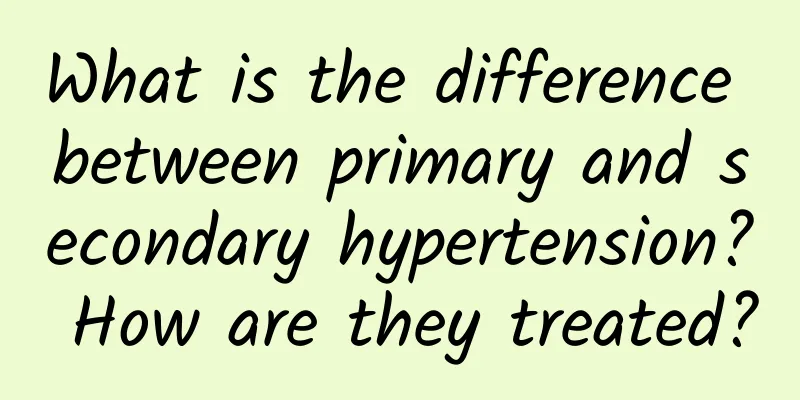What is the difference between primary and secondary hypertension? How are they treated?

|
Author: Mi Yuhong, Chief Physician, Beijing Anzhen Hospital, Capital Medical University Reviewer: Zhang Zhihai, Chief Physician, Guang'anmen Hospital, China Academy of Chinese Medical Sciences Hypertension, a chronic disease that troubles countless people, has gradually become an important issue of global public health and a major cause of diseases such as heart disease, stroke, and renal insufficiency. However, hypertension should not be generalized. In order to effectively control blood pressure, it is necessary to distinguish between primary hypertension and secondary hypertension, because the two have significant differences in etiology, clinical manifestations, and treatment. In terms of etiology, primary hypertension is also known as hypertension, which refers to hypertension for which the exact cause has not yet been found. It may be related to a variety of factors such as genetics, environment, and lifestyle habits. It is the most common type of hypertension, accounting for more than 90% of hypertensive patients. Secondary hypertension refers to hypertension caused by clear causes, which may include kidney disease, adrenal disease, renal vascular disease, etc. Although secondary hypertension accounts for a small proportion of hypertensive patients, once it is ignored, blood pressure control will be very difficult and may even affect the functions of important organs such as the heart, brain, and kidneys. In terms of clinical manifestations, primary hypertension usually has an insidious onset and a long course of disease, and patients may not have any symptoms for a long time. Therefore, many patients with primary hypertension often have target organ damage when they first visit the doctor. Secondary hypertension, on the other hand, often has an acute onset, more severe symptoms, and more accompanying symptoms. Patients may experience symptoms such as headache, fatigue, blurred vision, and in severe cases, they may even experience hypertensive crisis, which is life-threatening. Figure 1 Original copyright image, no permission to reprint In terms of diagnosis, it is necessary to comprehensively consider the medical history, physical examination results, laboratory tests and imaging examinations. The doctor will carry out targeted etiology screening according to the patient's specific situation, such as renal function tests, adrenal hormone level measurements, vascular ultrasound or CT angiography, etc., to rule out possible causes of secondary hypertension. For the treatment of primary hypertension, we mainly follow conventional methods. First of all, drug therapy is an important means of treating primary hypertension. According to the patient's age, gender, severity of the disease and other factors, choose appropriate antihypertensive drugs for individualized treatment. Commonly used antihypertensive drugs include angiotensin-converting enzyme inhibitors, calcium channel blockers, diuretics, etc. At the same time, we also need to pay attention to patients' non-drug treatments, such as changing bad living habits, losing weight, increasing exercise, etc. In addition, health education is also an important part of the treatment of primary hypertension. We need to help patients understand the harmfulness of hypertension and improve their self-management ability. The key to treating secondary hypertension is to find and treat its cause. For example, treating kidney disease, adrenal disease, renal vascular disease and other causes accordingly may cure hypertension. During the treatment process, we also need to pay close attention to the patient's blood pressure changes and adjust the treatment plan according to the patient's specific situation. It should be noted that whether it is primary hypertension or secondary hypertension, we need to pay attention to the prevention and treatment of complications. Hypertension may cause damage to multiple important organs such as the heart, brain, and kidneys, so we need to conduct relevant examinations regularly to detect and deal with related complications in a timely manner. In addition, good blood pressure control is not only reflected in meeting the blood pressure target, but also whether there are any discomfort symptoms when the blood pressure reaches the target. Long-term hypertensive patients should proceed step by step when receiving treatment, and should not affect the perfusion of important organs by over-emphasizing meeting the blood pressure target or lowering blood pressure quickly. Figure 2 Original copyright image, no permission to reprint |
<<: Why is hypertension called the "silent killer"? How to prevent and treat hypertension?
>>: Be careful! Swollen feet may be your heart's cry for help
Recommend
To be honest, your burp may be a "hold back fart"
"There are three urgent things in life"...
What should I do if I bleed during the 40th day of pregnancy?
Many patients have problems, so they need to pay ...
What causes itching, redness and swelling of the vagina?
The female genitals are very fragile. If you don&...
A foreign brand of ice cream was revealed to contain the carcinogenic substance ethylene oxide. Will you be poisoned if you eat it?
The weather was very hot this summer, and the col...
Why is it so dark down there?
If a woman's private parts are dark, it will ...
Normal reaction to using Funing suppository
Funing Suppository is a common gynecological medi...
Why are sausages also called hot dogs? Can hot dogs be baked in the oven?
It is one of the five major fast foods in the Wes...
Why does menstrual blood turn black after moxibustion?
After moxibustion, dark menstruation is a normal ...
Can pregnant women eat water chestnuts?
During pregnancy, pregnant women need to suppleme...
Shocked! Most people misunderstand whether myopia patients should wear glasses for a long time
Distinguishing true from false myopia - don't...
The follicle is too large and I am still pregnant
For some people who are preparing for pregnancy, ...
What causes pain when pressing on the outer side of the breast?
Tenderness on the outside of the breast may be ca...
What to eat after abortion
Some people will bleed after an abortion, and eve...
What if my period stops after one day?
For many female friends, the arrival of menstruat...
How to make the vagina alkaline?
Some women often suffer from gynecological inflam...









